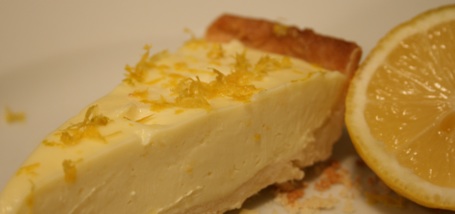The Most Extraordinary Lemon Cream Tart
This week’s Tuesdays With Dorie recipe was selected by Mary of Starting From Scratch. Even though I don’t like lemon desserts, I knew The Picky Apple would want to try this, and I got to brush up on several techniques that I don’t use regularly. This recipe made me realize just how incomplete my kitchen is. I do not have a thermometer, metal whisk (only a useless large plastic one), tart pan, or large food processor (only a mini processor I’m borrowing from my mom). Thankfully, my tart still turned out ok. The hardest part was whisking the cream in a double boiler without a thermometer. It took a long time-20 ro 30 minutes-whisking continuously, but it finally came together the way it was supposed to, and I managed not to burn it or scramble the eggs. Looking forward to next week’s recipe!
The Most Extraordinary Lemon Cream Tart (from Dorie Greenspan’s From My Home To Yours)
The filling in this tart is everything. It is the lemon cream I learned to make from Pierre Hermé, and it is the ne plus ultra of the lemon world. The tart is basic-a great crust, velvety lemon cream-and profoundly satisfying. It is also profoundly play-aroundable. You can add a fruit topping (circlets of fresh rasp-berries are spectacular with this tart) or a layer of fruit at the bottom; you can finish the tart with meringue; or you can serve it with anything from whipped cream to raspberry coulis.
1 9-inch tart shell made with Sweet Tart Dough, fully baked and cooled
1 cup sugar
Finely grated zest of 3 lemons
4 large eggs
½ cup fresh lemon juice (from 4-5 lemons)
2 sticks plus 5 tablespoons (10½ ounces) unsalted butter, cut into tablespoon-size
pieces, at room temperature
Getting Ready: Have an instant-read thermometer, a strainer and a blender (first choice) or food processor at hand. Bring a few inches of water to a simmer in a saucepan.
Put the sugar and zest in a large heatproof bowl that can be set over the pan of simmering water. Off the heat, rub the sugar and zest together between your fingers until the sugar is moist, grainy and very aromatic. Whisk in the eggs, followed by the lemon juice.
Set the bowl over the pan, and start stirring with the whisk as soon as the mixture feels tepid to the touch. Cook the lemon cream until it reaches 180 degrees F. As you whisk-you must whisk constantly to keep the eggs from scrambling-you’ll see that the cream will start out light and foamy, then the bubbles will get bigger, and then, as it gets closer to 180 degrees F, it will start to thicken and the whisk will leave tracks. Heads up at this point-the tracks mean the cream is almost ready. Don’t stop whisking or checking the temperature, and have patience-depending on how much heat you’re giving the cream, getting to temp can take as long as 10 minutes.
As soon as it reaches 180 degrees F, remove the cream from the heat and strain it into the container of the blender (or food processor); discard the zest. Let the cream stand, stirring occasionally, until it cools to 140 degrees F, about 10 minutes.
Turn the blender to high (or turn on the processor) and, with the machine going, add the butter about 5 pieces at a time. Scrape down the sides of the container as needed as you incorporate the butter. Once the butter is in, keep the machine going-to get the perfect light, airy texture of lemon-cream dreams, you must continue to blend the cream for another 3 minutes. If your machine protests and gets a bit too hot, work in 1-minute intervals, giving the machine a little rest between beats.
Pour the cream into a container, press a piece of plastic wrap against the surface to create an airtight seal and refrigerate for at least 4 hours or overnight. (The cream will keep in the fridge for 4 days and, or tightly sealed, in the freezer for up to 2 months; thaw it overnight in the refrigerator.)
When you are ready to assemble the tart, just whisk the cream to loosen it and spoon it into the tart shell. Serve the tart, or refrigerate ‘until needed.
Serving: It’s a particular pleasure to have this tart when the cream is cold and the crust is at room temperature. A raspberry or other fruit coulis is nice, but not necessary; so is a little crème fraîche. I know it sounds odd to offer something as rich as crème fraîche with a tart like this, but it works because the lemon cream is so light and so intensely citric, it doesn’t taste or feel rich.
Storing: While you can make the lemon cream ahead, once the tart is constructed, it’s best to eat it the day it is made.
Sweet Tart Dough:
Makes enough for one 9-inch crust
Storing: Well wrapped, the dough can be kept in the refrigerator for up to 5 days or frozen for up to 2 months. While the fully baked crust can be packed airtight and frozen for up to 2 months, I prefer to freeze the unbaked crust in the pan and bake it directly from the freezer-it has a fresher flavor. Just add about 5 minutes to the baking time.
In French, this dough is called pâte sablée because it is buttery, tender and sandy (that’s what sablée means). It’s much like shortbread, and it’s ideal for filling with fruit, custard or chocolate.
The simplest way to make a tart shell with this dough is to press it into the pan. You can roll out the dough, but the high proportion of butter to flour and the inclusion of confectioners’ sugar makes it finicky to roll. I always press it into the pan, but if you want to roll it, I suggest you do so between sheets of plastic wrap or wax paper or inside a rolling slipcover.
1½ cups all-purpose flour
½ cup (2 ounces) confectioners’ sugar
¼ teaspoon salt
1 stick plus 1 tablespoon (9 tablespoons) very cold (or frozen) unsalted butter, cut into small pieces
1 large egg yolk
Put the flour, confectioners’ sugar and salt in a food processor and pulse a couple of times to combine. Scatter the pieces of butter over the dry ingredients and pulse until the butter is coarsely cut in-you should have some pieces the size of oatmeal flakes and some the size of peas. Stir the yolk, just to break it up, and add it a little at a time, pulsing after each addition. When the egg is in, process in long pulses-about 10 seconds each-until the dough, which will look granular soon after the egg is added, forms clumps and curds. Just before you reach this stage, the sound of the machine working the dough will change-heads up. Turn the dough out onto a work surface and, very lightly and sparingly, knead the dough just to incorporate any dry ingredients that might have escaped mixing.
To press the dough into the pan: Butter a 9-inch fluted tart pan with a removable bottom. Press the dough evenly over the bottom and up the sides of the pan, using all but one little piece of dough, which you should save in the refrigerator to patch any cracks after the crust is baked. Don’t be too heavy-handed-press the crust in so that the edges of the pieces cling to one another, but not so hard that the crust loses its crumbly texture. Freeze the crust for at least 30 minutes, preferably longer, before baking.
Center a rack in the oven and preheat the oven to 375 degrees F.
Butter the shiny side of a piece of aluminum foil and fit the foil, buttered side down, tightly against the crust. (Since you froze the crust, you can bake it without weights.) Put the tart pan on a baking sheet and bake the crust for 25 minutes. Carefully remove the foil. If the crust has puffed, press it down gently with the back of a spoon.
Bake for another 8 minutes or so, or until it is firm and golden brown. (I dislike lightly baked crusts, so I often keep the crust in the oven just a little longer. If you do that, just make sure to keep a close eye on the crust’s progress-it can go from golden to way too dark in a flash.) Transfer the tart pan to a rack and cool the crust to room temperature before filling.
To patch a partially or fully baked crust, if necessary: If there are any cracks in the baked crust, patch them with some of the reserved raw dough as soon as you remove the foil. Slice off a thin piece of the dough, place it over the crack, moisten the edges and very gently smooth the edges into the baked crust. If the tart will not be baked again with its filling, bake for another 2 minutes or so, just to take the rawness off the patch.



As a coworker of the Picky Apple, I’ve had the pleasure of enjoying many of the recipes presented here. They have all been wonderful, and the lemon tart is one of the best desserts I’ve ever had!
Thanks for feeding us so well. Your recipes are highly anticipated in the HNL coffee corner.
Cheers,
Ann
I’m impressed with your product without using all the bells and whistles! It just goes to show the world did go on before food processors and thermometers! Great job and beautiful tart!
I liked it. At first I thought it was too lemony, but after I ate a couple more bites I liked it a lot. Nice and creamy. Thanks for the treats each week.
Your tart looks perfect! Just goes to show that all of the kitchen gadgets can be overrated!
Your tart looks beautiful, and you must have some serious muscles after all that whisking!
I managed it without a thermometer too. Congrats!
Looks delicious! I am with you on having an incomplete kitchen!
No thermometer here either. Just gotta make it work! Tart looks lovely. Great job!
Clara @ I♥food4thought
great job on your tart in spite of not having a thermometer!
Lovely picture, great job! (I bought tart pans for this one – so glad for that Michael’s 50% off coupon. I’m slowly but surely building a “real” kitchen!)
Great job for doing it without all the gadgets most of us take for granted!
Sounds like your friends really love you and/or your desserts!
well, your tart still looks pretty and yummy even though you might not have all the utensils called for in the recipe. love the lemon zest on top!
Gorgeous tart! I also lack so many things in my kitchen and recipes like this one help remind me of that!
Your tart is lovely. Glad you were successful in spite of not having all the useful equipment.
Your tart looks wonderful!
P.S. I also have an incomplete kitchen with a flimsy plastic whisk… so annoying!
I’ve made this recipe a few times, and it is my favorite! Your tart looks wonderful!
Looks beautiful with that garnish! Wow!
Very lovely with the lemon zest on top, it looks so airy. Beautiful!
holy crap, that looks good. i love love love lemon tart. shoot. i have to make one of those now.
That tart looks amazing! (and I don’t have a metal whisk either :).
That’s a beautiful slice of lemon cream tart, and I sure wish I had a piece right this moment!
Welcome aboard!